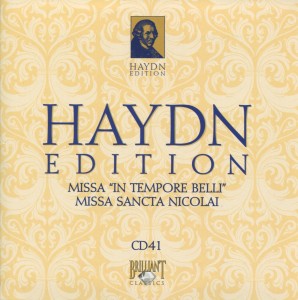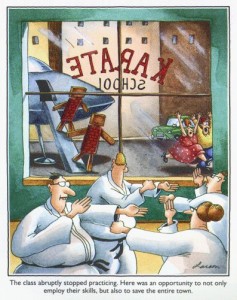 My day started early, even by my standards – somewhere around 4:30am.
My day started early, even by my standards – somewhere around 4:30am.
I don’t know why.
Once up, it’s always tough for me to return to my previous state of slumber. So, I made the best of it.
I watched Sons of Anarchy, Season One, Episodes 1 and 2. I read the latest issue of Tricycle magazine. And then, around 6:30, I headed to Denny’s, where I now sit…listening to Haydn’s Mass in Time of War (Missa “In Tempora Belli”) while watching people who bear a scary resemblance to a Far Side comic.
Opera has not been a favorite of mine. It’s not that I don’t appreciate the talent – especially the vocal talent – required to master this art form. I do appreciate it. Deeply. (Well, maybe not deeply. But at least superficially. Earnestly superficially.)
Just between you and me, I gained deep appreciation for two opera singers when I listened to everything Mozart composed: Nicolai Gedda and Pilar Lorengar, especially their electrifying performance of the Love Duet from Madame Butterfly.
The notes they hit…
Well, watch them hit said notes for yourself:
Pay special attention to 4:09 into the clip. I get the chills every time I watch that.
So, you see, no one can say I hate opera. I don’t. Really.
It’s just, as my dad used to say, “I don’t care for that.”
Granted, what I’m listening to this morning while watching the Far Side people discuss their bacon strips and toast (how many of each? that is the question that engages them) is not Nicolai Gedda and Pilar Lorengar. For the record, it’s soprano Elisabeth Thomann and tenor Stafford Wing in Missa “In Tempore Belli” in C.
And you can hear them for yourself in the YouiTube clip below. That’s precisely what’s providing the soundtrack to the aforementioned Far Side people this morning:
The background of this mass is an interesting one, if Wikipedia is to be believed:
Haydn composed this mass at Eisenstadt in August 1796, at the time of Austria’s general mobilisation into war. Four years into the European war that followed the French Revolution, Austrian troops were doing badly against the French in Italy and Germany, and Austria feared invasion. Reflecting the troubled mood of his time, Haydn’s potent integration of references to battle in the Benedictus and Agnus Dei movements is inspired. The Mass was first performed on December 26, 1796, in the Piarist Church of Maria Treu in Vienna.
Haydn was a deeply religious man, who appended the words “Praise be to God” at the end of every completed score…
This piece has been long thought to express an anti-war sentiment, even though there is no explicit message in the text itself, and no clear indication from Haydn that this was his intention. What is found in the score is a very unsettled nature to the music, not normally associated with Haydn, which has led scholars to the conclusion that it is anti-war in nature. This is especially noticed in the Benedictus and Agnus Dei. During the time of the composition of the Mass, the Austrian government had issued a decree in 1796, that “no Austrian should speak of peace until the enemy is driven back to its customary borders.” Whether this is enough to call it anti-war in nature is certainly debatable because most of the mass is of a lyrically joyful nature.
Haydn was 64 when he composed Missa “In Tempore Belli.”
As one might expect, I like the brisker parts:
1. Kyrie
2. Gloria
3. Credo
I don’t know if all masses sound the same to me, or if their composers borrowed musical ideas from one another. But parts of the first three resemble some of the great masses, such as Handel’s Messiah, Hallelujah Chorus.
Of course, the Mass as a musical composition always follows the same liturgical formula. What would vary, I suppose, is the music and the vocalists. But the structure seems to be consistent with all masses.
Not much room for variations on a theme.
The next mass on today’s CD is Missa Sancta Nicolai in G HOB XXII:6, written in 1772.
You can hear it for yourself by clicking on the YouTube clip below.
NOTE: That’s precisely the version to which I’m listening this morning.
Between the two of these masses, I prefer the opening three parts of the first one, and the totality of the second one. And I’m not sure I can explain why.
For me, the only way to enjoy a mass is if I:
1. Know Latin, or have a good translation at hand,
2. Become super-devout (Latvian Orthodox, in Seinfeld terms), and/or
3. Really dig the complexity of the music, and/or the quality of the voices
Since the first two aren’t likely, what I need to dig a mass is complex, usually sprightly, music, and voices that absolutely blow me away.
These masses are okay. But they’re typical masses. No surprises.
Granted, I’m no musicologist. So I cannot discern the nuances — or even the blatantly obvious — portions of these compositions. Therefore, I do not know if they’re considered remarkable or not. When I hear music for the first time I ask myself if I’d listen to it again.
Regarding these two Haydn masses, the answer to that question is no.
Again, not because I don’t dig opera-like Classical music. It’s because life is too short to spend it listening to something that doesn’t totally turn my crank.
Here’s a complete list of masses by Haydn.


Ha! “Earnestly superficially.” That was funny. I guess I’m not Latvian Orthodox enough either, because these are pretty, but don’t really turn my crank, either.
Isn’t it hilarious what people discuss in restaurants, airports, etc.? I’m always amazed at some tidbit of totally bizarre conversation I pick up without even meaning to.